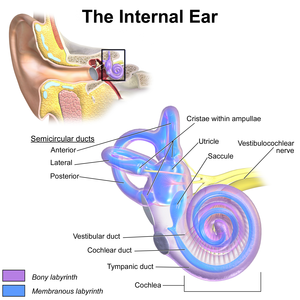| This article relies largely or entirely on a single source. Relevant discussion may be found on the talk page. Please help improve this article by introducing citations to additional sources. Find sources: "Vestibular duct" – news · newspapers · books · scholar · JSTOR (November 2024) |
| Vestibular duct | |
|---|---|
 Inner ear, with vestibular duct labeled near bottom. Inner ear, with vestibular duct labeled near bottom. | |
 Cross section of the cochlea. Cross section of the cochlea. | |
| Details | |
| Identifiers | |
| Latin | scala vestibuli |
| MeSH | D054738 |
| TA98 | A15.3.03.043 |
| TA2 | 6968 |
| FMA | 61269 |
| Anatomical terminology[edit on Wikidata] | |
The vestibular duct or scala vestibuli is a perilymph-filled cavity inside the cochlea of the inner ear that conducts sound vibrations to the cochlear duct.
It is separated from the cochlear duct by Reissner's membrane and extends from the vestibule of the ear to the helicotrema where it joins the tympanic duct.
Additional images
-
 The cochlea and vestibule, viewed from above.
The cochlea and vestibule, viewed from above.
-
 Transverse section of the cochlear duct of a fetal cat.
Transverse section of the cochlear duct of a fetal cat.
-
 Interior of right osseous labyrinth.
Interior of right osseous labyrinth.
-
 Diagrammatic longitudinal section of the cochlea.
Diagrammatic longitudinal section of the cochlea.
See also
References
- "Enlarged Vestibular Aqueducts (EVA) & Hearing Loss". National Institute of Deafness and Other Communication Disorders (NIDCD). 13 February 2017. Retrieved 6 November 2024.
internal websites
- Slide from University of Kansas
- Diagram at Indiana University – Purdue University Indianapolis
- Image at University of New England (United States)
| Anatomy of hearing and balance | |||||||||||||||
|---|---|---|---|---|---|---|---|---|---|---|---|---|---|---|---|
| Outer ear | |||||||||||||||
| Middle ear |
| ||||||||||||||
| Inner ear |
| ||||||||||||||